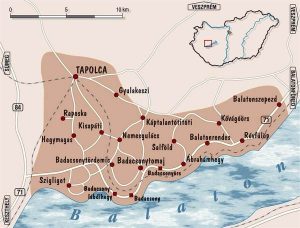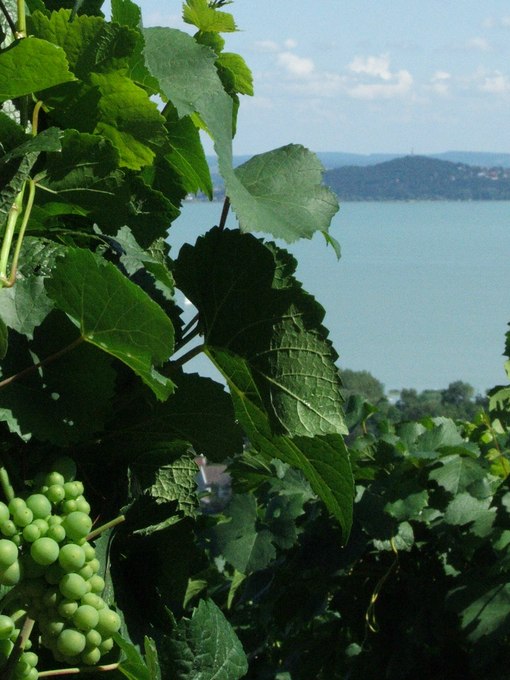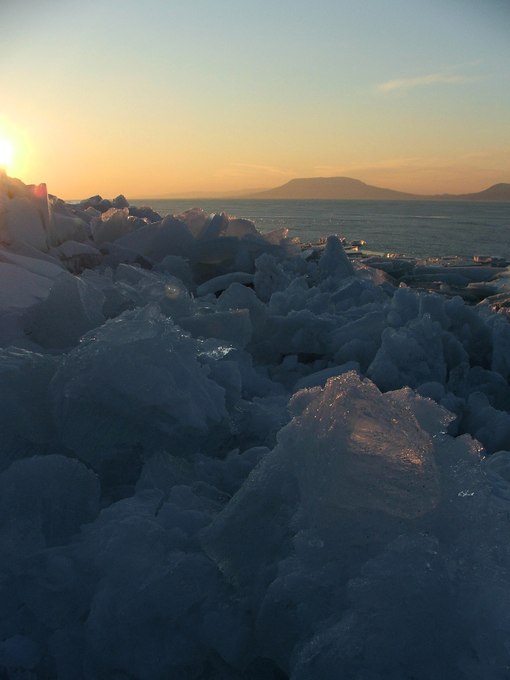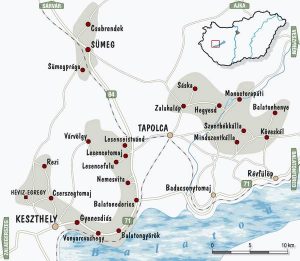Balaton region
The Balaton is the largest lake in Central Europe, known as a holiday destination by young people and families. However, there is another world to explore besides that of swimming, camping and sailing, and this world can also be appreciated when the summer sun has already faded. The lake’s huge surface creates a special microclimate for viticulture. It is, therefore, no coincidence that both the southern and the northern shore are lined with beautiful vineyards and vines. Both royal, ecclesiastical and aristocratic vineyards and also estates owned by the gentry and peasants have been producing lovely wines in this area for centuries. Nowadays, this region boasting around 9,000 hectares of vines is divided into six wine districts: Badacsony, Balaton Felvidék (Balaton Highlands), Balatonfüred-Csopak, Balatonboglár, Zala and Nagy-Somló.
The Nagy & Nagy Winery has its own vineyards in two of the wine districts belonging to Balaton wine region – Badacsony and Balaton Felvidék.

Badacsony wine district
Production area: 1,400 hectares
Soil conditions: The slopes of the volcanic hills are covered with Pannonian clay, Pannonian sand and, in some places, loess. Moving towards the top of the hill, this is rather mixed with basalt and basalt tuff.
Climate: Its climate is positively influenced by the waters of the Balaton. This creates a favourable microclimate for vines, especially in sunny, protected areas on south-southwest-facing slopes. The large body of water prevents the development of temperature extremes and also ensures higher air humidity.
Most important grape varieties: Olaszrizling, Szürkebarát (Pinot Gris), Kéknyelű, Muscat Ottonel, Riesling, Müller-Thurgau Chardonnay, Pinot Noir
 Archaeological findings demonstrate that viticulture was already flourishing around Badacsony Hill 2000 years ago. One of the famous Roman military routes passed by at its foot, leading right to Aquincum and the Danube. In the 13th century, much of the wine region fell into the hands of the church while from the 18th century, many aristocratic families competed for its vineyards. The landscape of the northern shore of Lake Balaton from Révfülöp to Szigliget is dominated by the eroded basalt cones of former volcanoes. Besides Badacsony, the best known are Szent György-hegy, Gulács, Tóti-hegy and Csobanc. Sunny, protected areas on the wine district’s south-southwest-facing slopes provide a sub-Mediterranean microclimate favourable for viticulture. In some places, the slopes are covered with loess soils, but as you move towards the hilltop, they are increasingly characterised by basalt and basalt tuff debris, which absorbs the heat in the daytime and radiates it back to the soil and vines at night. This means that Badacsony white wines are typically mineral, full-bodied with high acidity and long-lived. In the 20th century, Olaszrizling became the wine district’s dominant grape variety, while Szürkebarát, Muscat Ottonel and Riesling are also widely cultivated. Badacsony’s emblematic variety, Kéknyelű, can be recognised primarily by its spicy aromas. Interestingly, it only has female flowers and so cannot fertilise itself. There are very few such grape varieties in the world. Harking back to the past, some winemakers are also trying to produce red wine again, primarily from Pinot Noir. Late-harvest sweet wines and ice wines are also produced in suitable vintages.
Archaeological findings demonstrate that viticulture was already flourishing around Badacsony Hill 2000 years ago. One of the famous Roman military routes passed by at its foot, leading right to Aquincum and the Danube. In the 13th century, much of the wine region fell into the hands of the church while from the 18th century, many aristocratic families competed for its vineyards. The landscape of the northern shore of Lake Balaton from Révfülöp to Szigliget is dominated by the eroded basalt cones of former volcanoes. Besides Badacsony, the best known are Szent György-hegy, Gulács, Tóti-hegy and Csobanc. Sunny, protected areas on the wine district’s south-southwest-facing slopes provide a sub-Mediterranean microclimate favourable for viticulture. In some places, the slopes are covered with loess soils, but as you move towards the hilltop, they are increasingly characterised by basalt and basalt tuff debris, which absorbs the heat in the daytime and radiates it back to the soil and vines at night. This means that Badacsony white wines are typically mineral, full-bodied with high acidity and long-lived. In the 20th century, Olaszrizling became the wine district’s dominant grape variety, while Szürkebarát, Muscat Ottonel and Riesling are also widely cultivated. Badacsony’s emblematic variety, Kéknyelű, can be recognised primarily by its spicy aromas. Interestingly, it only has female flowers and so cannot fertilise itself. There are very few such grape varieties in the world. Harking back to the past, some winemakers are also trying to produce red wine again, primarily from Pinot Noir. Late-harvest sweet wines and ice wines are also produced in suitable vintages.


Balaton Felvidék wine district
Production area: 1,000 hectares
Soil conditions: These are similar to the Balaton wine region, but are more diverse: dolomite on Pannonian clay, sandstone detritus, loess and a layer of Pleistocene sand, Triassic limestone, marl, Pannonian sand, clay, rendzina on compounded basalt tuff, clay-rich brown forest soils, brown soils, chernozem brown forest soils, and rocky and earthy scrubland.
Climate: Its climate is not as temperate (especially those areas further from the lake) as that of the neighbouring Badacsony wine district, although its cultivation conditions are generally similar to those of the Badacsony wine district.
Most important grape varieties: Olaszrizling, Chardonnay, Szürkebarát (Pinot Gris), Zöldveltelini (Grüner Veltliner), Sauvignon Blanc, Müller-Thurgau, Irsai Olivér, Zenit, Pinot Noir and Kékfrankos

A little hidden from the summer tourist hustle and bustle on the Balaton shore, the small villages nestling among the hills of the Balaton Felvidék conceal plenty of value. The noble mansions, cellars, Roman relics, Sümeg castle, the natural beauty of the Kál Basin, the rich folk culture and the artists who have settled here all create an intimate and genial atmosphere.
This is a died-in-the-wool white wine region, which produces both characterful, full-bodied, mineral wines and light, aromatic, fruity summer wines on its varied soils. The wine district can be divided into two typical parts – the eastern part is rather characterised by volcanic soils while forest soils are more typical in the western. All the most important vineyards are surrounded by forests, which lends them a typical microclimate. The summer heat is tempered by the cooler forest air in the evenings, so that the grapes’ acidity and fruity aromas are preserved beautifully.
Olaszrizling is the main variety (60%) cultivated on the 1,000 hectares or so, but there is also full-bodied, aromatic Pinot Gris and some serious Chardonnay. More recently, aromatic Irsai Olivér, Zenit and Sauvignon Blanc as well as small amounts of Kékfrankos and Pinot Noir rosé and red wines add variety to its image.
